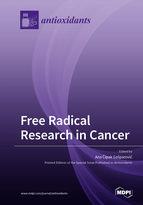Free Radical Research in Cancer
A special issue of Antioxidants (ISSN 2076-3921). This special issue belongs to the section "Health Outcomes of Antioxidants and Oxidative Stress".
Deadline for manuscript submissions: closed (30 October 2019) | Viewed by 66698
Special Issue Editor
Special Issues, Collections and Topics in MDPI journals
Special Issue Information
Dear Colleagues,
It is a pleasure to invite you to contribute to this Special Issue of Antioxidants by submitting original research papers or review articles focusing on “Free Radical Research in Cancer”.
Cancer is a great challenge to efficient therapy due to biological diversity. Disturbed oxidative homeostasis in cancer cells certainly contributes to differential therapy response. One of the hallmarks of cancer cells is adaptation, which includes fine tuning of the cellular metabolic and signalling pathways, as well as transcription profiles. One of the factors causing rapid adaptation are changes in oxygen levels due to hypoxia/reoxygenation during growth changing antioxidative patterns as a consequence. Finally, these events sum up and create challenges for efficient cancer therapy.
The aim of this Special Issue is to present recent findings and to describe the state-of-the-art on the mechanisms by which free radicals contribute to cancer development and change response to therapy.
We look forward to receiving many contributions and stimulating a productive discussion on this exciting thematic of role of free radicals in cancer development, progression and treatment.
Best regards,
Dr. Ana Čipak Gašparović
Guest Editor
Manuscript Submission Information
Manuscripts should be submitted online at www.mdpi.com by registering and logging in to this website. Once you are registered, click here to go to the submission form. Manuscripts can be submitted until the deadline. All submissions that pass pre-check are peer-reviewed. Accepted papers will be published continuously in the journal (as soon as accepted) and will be listed together on the special issue website. Research articles, review articles as well as short communications are invited. For planned papers, a title and short abstract (about 100 words) can be sent to the Editorial Office for announcement on this website.
Submitted manuscripts should not have been published previously, nor be under consideration for publication elsewhere (except conference proceedings papers). All manuscripts are thoroughly refereed through a single-blind peer-review process. A guide for authors and other relevant information for submission of manuscripts is available on the Instructions for Authors page. Antioxidants is an international peer-reviewed open access monthly journal published by MDPI.
Please visit the Instructions for Authors page before submitting a manuscript. The Article Processing Charge (APC) for publication in this open access journal is 2900 CHF (Swiss Francs). Submitted papers should be well formatted and use good English. Authors may use MDPI's English editing service prior to publication or during author revisions.
Keywords
- free radicals
- oxidative stress
- ROS
- RNS
- cancer
- cancer stem cells
- cancer therapy
- cell signalling
- antioxidative transcription factors
- drug delivery system
Related Special Issues
- Antioxidants in Cancer in 2021 in Antioxidants (3 articles)
- Dietary Antioxidants in Cancer Chemoprevention in Antioxidants (8 articles)







